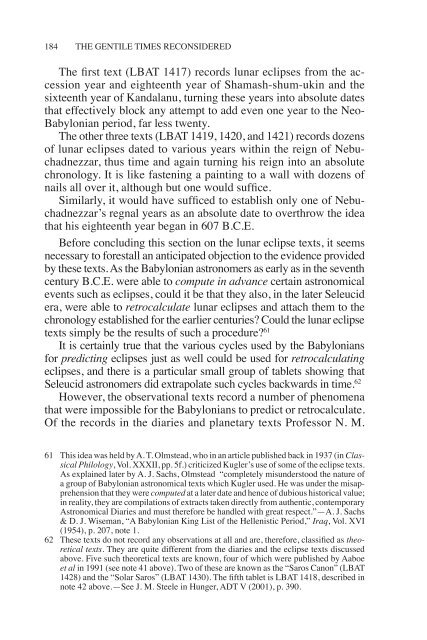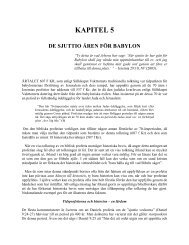4 the absolute chronology of the neo-babylonian era - Kristen Frihet
4 the absolute chronology of the neo-babylonian era - Kristen Frihet
4 the absolute chronology of the neo-babylonian era - Kristen Frihet
Create successful ePaper yourself
Turn your PDF publications into a flip-book with our unique Google optimized e-Paper software.
184 THE GENTILE TIMES RECONSIDERED<br />
The first text (LBAT 1417) records lunar eclipses from <strong>the</strong> accession<br />
year and eighteenth year <strong>of</strong> Shamash-shum-ukin and <strong>the</strong><br />
sixteenth year <strong>of</strong> Kandalanu, turning <strong>the</strong>se years into <strong>absolute</strong> dates<br />
that effectively block any attempt to add even one year to <strong>the</strong> Neo-<br />
Babylonian period, far less twenty.<br />
The o<strong>the</strong>r three texts (LBAT 1419, 1420, and 1421) records dozens<br />
<strong>of</strong> lunar eclipses dated to various years within <strong>the</strong> reign <strong>of</strong> Nebuchadnezzar,<br />
thus time and again turning his reign into an <strong>absolute</strong><br />
<strong>chronology</strong>. It is like fastening a painting to a wall with dozens <strong>of</strong><br />
nails all over it, although but one would suffice.<br />
Similarly, it would have sufficed to establish only one <strong>of</strong> Nebuchadnezzar’s<br />
regnal years as an <strong>absolute</strong> date to overthrow <strong>the</strong> idea<br />
that his eighteenth year began in 607 B.C.E.<br />
Before concluding this section on <strong>the</strong> lunar eclipse texts, it seems<br />
necessary to forestall an anticipated objection to <strong>the</strong> evidence provided<br />
by <strong>the</strong>se texts. As <strong>the</strong> Babylonian astronomers as early as in <strong>the</strong> seventh<br />
century B.C.E. were able to compute in advance certain astronomical<br />
events such as eclipses, could it be that <strong>the</strong>y also, in <strong>the</strong> later Seleucid<br />
<strong>era</strong>, were able to retrocalculate lunar eclipses and attach <strong>the</strong>m to <strong>the</strong><br />
<strong>chronology</strong> established for <strong>the</strong> earlier centuries? Could <strong>the</strong> lunar eclipse<br />
texts simply be <strong>the</strong> results <strong>of</strong> such a procedure? 61<br />
It is certainly true that <strong>the</strong> various cycles used by <strong>the</strong> Babylonians<br />
for predicting eclipses just as well could be used for retrocalculating<br />
eclipses, and <strong>the</strong>re is a particular small group <strong>of</strong> tablets showing that<br />
Seleucid astronomers did extrapolate such cycles backwards in time. 62<br />
However, <strong>the</strong> observational texts record a number <strong>of</strong> phenomena<br />
that were impossible for <strong>the</strong> Babylonians to predict or retrocalculate.<br />
Of <strong>the</strong> records in <strong>the</strong> diaries and planetary texts Pr<strong>of</strong>essor N. M.<br />
61 This idea was held by A. T. Olmstead, who in an article published back in 1937 (in Classical<br />
Philology, Vol. XXXII, pp. 5f.) criticized Kugler’s use <strong>of</strong> some <strong>of</strong> <strong>the</strong> eclipse texts.<br />
As explained later by A. J. Sachs, Olmstead “completely misunderstood <strong>the</strong> nature <strong>of</strong><br />
a group <strong>of</strong> Babylonian astronomical texts which Kugler used. He was under <strong>the</strong> misapprehension<br />
that <strong>the</strong>y were computed at a later date and hence <strong>of</strong> dubious historical value;<br />
in reality, <strong>the</strong>y are compilations <strong>of</strong> extracts taken directly from au<strong>the</strong>ntic, contemporary<br />
Astronomical Diaries and must <strong>the</strong>refore be handled with great respect.”—A. J. Sachs<br />
& D. J. Wiseman, “A Babylonian King List <strong>of</strong> <strong>the</strong> Hellenistic Period,” Iraq, Vol. XVI<br />
(1954), p. 207, note 1.<br />
62 These texts do not record any observations at all and are, <strong>the</strong>refore, classified as <strong>the</strong>oretical<br />
texts. They are quite different from <strong>the</strong> diaries and <strong>the</strong> eclipse texts discussed<br />
above. Five such <strong>the</strong>oretical texts are known, four <strong>of</strong> which were published by Aaboe<br />
et al in 1991 (see note 41 above). Two <strong>of</strong> <strong>the</strong>se are known as <strong>the</strong> “Saros Canon” (LBAT<br />
1428) and <strong>the</strong> “Solar Saros” (LBAT 1430). The fifth tablet is LBAT 1418, described in<br />
note 42 above.—See J. M. Steele in Hunger, ADT V (2001), p. 390.




